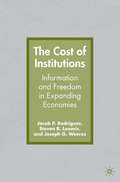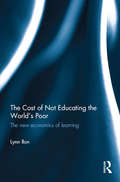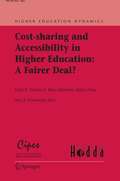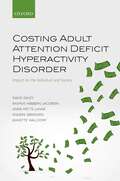- Table View
- List View
The Cost of Development in China
by Guangyu HuThis book focuses on the future of China and its sustainable development, and summarizes the implications, forms, causes, countermeasures and related rules of the main costs generated during a country’s period of development, so as to provide a theoretical reference and decision-making consulting tools for institutions and scientific governance and management professionals. Combining China’s national situation and development characteristics with the country as a unit, it uses case studies to propose the concept of cost theory and the theoretical system of national development cost. Focusing on the goals of innovation in nation building, common development and prosperity, as well as enhancement of people’s net welfare, the book summarizes and draws conclusions about various aspects of national development, including economic development cost; political, social and cultural development cost; foreign opening-up development cost and nature development cost. It primarily establishes an indicator system of national development cost for promoting full-factor productivity and reducing development cost, and provides a theoretical basis for implementing the scientific political-achievement view.
The Cost of Free Shipping: Amazon in the Global Economy (Wildcat)
by Jake Alimahomed-Wilson, Ellen ReeseAmazon is the most powerful corporation on the planet and its CEO, Jeff Bezos, has become the richest person in history, and one of the few people to profit from a global pandemic. Its dominance has reshaped the global economy itself: we live in the age of 'Amazon Capitalism'. 'One-click' instant consumerism and its immense variety of products has made Amazon a worldwide household name, with over 60% of US households subscribing to Amazon Prime. In turn, these subscribers are surveilled by the corporation. Amazon is also one of the world's largest logistics companies, resulting in weakened unions and lowered labor standards. The company has also become the largest provider of cloud-computing services and home surveillance systems, not to mention the ubiquitous Alexa. With cutting-edge analyses, this book looks at the many dark facets of the corporation, including automation, surveillance, tech work, workers' struggles, algorithmic challenges, the disruption of local democracy and much more. The Cost of Free Shipping shows how Amazon represents a fundamental shift in global capitalism that we should name, interrogate and be primed to resist.
The Cost of Free Shipping: Amazon in the Global Economy (Wildcat)
Amazon is the most powerful corporation on the planet and its CEO, Jeff Bezos, has become the richest person in history, and one of the few people to profit from a global pandemic. Its dominance has reshaped the global economy itself: we live in the age of 'Amazon Capitalism'. 'One-click' instant consumerism and its immense variety of products has made Amazon a worldwide household name, with over 60% of US households subscribing to Amazon Prime. In turn, these subscribers are surveilled by the corporation. Amazon is also one of the world's largest logistics companies, resulting in weakened unions and lowered labor standards. The company has also become the largest provider of cloud-computing services and home surveillance systems, not to mention the ubiquitous Alexa. With cutting-edge analyses, this book looks at the many dark facets of the corporation, including automation, surveillance, tech work, workers' struggles, algorithmic challenges, the disruption of local democracy and much more. The Cost of Free Shipping shows how Amazon represents a fundamental shift in global capitalism that we should name, interrogate and be primed to resist.
The Cost of Institutions: Information and Freedom in Expanding Economies
by J. Rodriguez S. Loomis J. WeeresContesting prior assumptions that institutions simplify the world for the sake of efficiency, this book argues that rather than institution expansion indicating the movement of markets to optimal states, expanding institutions generate information costs.
The Cost of Land Use Decisions: Applying Transaction Cost Economics to Planning and Development
by Edwin BuitelaarThis important new book tackles the ongoing debate between market and government in planning. By applying transaction cost economics to an evaluation of land use systems, the author provides a fresh angle and a useful contribution to a growing field of study for researchers in urban planning, public administration and land economics. The book explains the relevance of the cost of land use decisions to planning practice and analyses institutions and transaction costs. The author offers evidence from three systematic empirical studies with detailed analyses of the planning of Nijmegen - Holland being known for its plan-led development; Bristol - where the UK planning system is characterised by being development-led and discretionary; and Houston - generally regarded as the city with no planning at all.
The Cost of Not Educating the World's Poor: The new economics of learning
by Lynn IlonIn The Cost of Not Educating the World’s Poor, Lynn Ilon observes from her 30 years of travel and work in some 20 developing countries, how global instability, problems of environmental degradation, spread of global disease, migration and political instability are a cost of viewing the uneducated poor as separated from a networked of fast-growing global knowledge. This book shows how powerful global learning systems are rapidly forming and linking the rich world with the world of the poor and developing nations. Using a narrative voice interleaved with concise introductions to the underlying theories (economics, development, learning, technology and networks) it shows us how changing our ways of thinking can lead to new possibilities. The Cost of Not Educating the World’s Poor is based on an emerging theory of development economics and the author’s own vast experiences and stories. It also discusses, among other issues: International development and how it has evolved toward an emphasis on knowledge How networked human capital creates new potential for poorly resourced countries The formation of a global system of learning networks The digitization of knowledge How nations improve their well-being through knowledge and equity This inter-disciplinary assessment of international learning inequality and the methods to overcome it will appeal to researchers concerned with emerging concepts of global learning networks and their effects on development. It will also be of interest to students and policymakers studying national inequality, economics, and global development.
The Cost of Not Educating the World's Poor: The new economics of learning
by Lynn IlonIn The Cost of Not Educating the World’s Poor, Lynn Ilon observes from her 30 years of travel and work in some 20 developing countries, how global instability, problems of environmental degradation, spread of global disease, migration and political instability are a cost of viewing the uneducated poor as separated from a networked of fast-growing global knowledge. This book shows how powerful global learning systems are rapidly forming and linking the rich world with the world of the poor and developing nations. Using a narrative voice interleaved with concise introductions to the underlying theories (economics, development, learning, technology and networks) it shows us how changing our ways of thinking can lead to new possibilities. The Cost of Not Educating the World’s Poor is based on an emerging theory of development economics and the author’s own vast experiences and stories. It also discusses, among other issues: International development and how it has evolved toward an emphasis on knowledge How networked human capital creates new potential for poorly resourced countries The formation of a global system of learning networks The digitization of knowledge How nations improve their well-being through knowledge and equity This inter-disciplinary assessment of international learning inequality and the methods to overcome it will appeal to researchers concerned with emerging concepts of global learning networks and their effects on development. It will also be of interest to students and policymakers studying national inequality, economics, and global development.
The Cost of Sexism: How the Economy is Built for Men and Why We Must Reshape It | A GUARDIAN SCIENCE BOOK OF THE YEAR
by Professor Linda ScottA GUARDIAN SCIENCE BOOK OF THE YEARSHORTLISTED FOR THE 2020 ROYAL SOCIETY INSIGHT INVESTMENT SCIENCE BOOK PRIZELONGLISTED FOR THE 2020 FINANCIAL TIMES AND McKINSEY BUSINESS BOOK OF THE YEARAn urgent analysis of global gender inequality and a passionately argued case for change by a pioneer in the movement for women's economic empowerment. 'Passionate and timely . . . in a world where so many of us stick to criticising the status quo, it's heartening to read someone willing to offer viable solutions.'CAROLINE CRIADO-PEREZ, OBSERVER (author of Invisible Women)'A compelling and actionable case for unleashing women's economic power.'MELINDA GATESThe Cost of Sexism is an urgent analysis of global gender inequality and a fervently argued case for change by a pioneer in the movement for women's economic empowerment. Drawing on decades of statistical evidence, original research and global on-the-ground experience, Linda Scott outlines a revolutionary, actionable plan to remove economic barriers against women, and in the process combat humankind's most pressing problems.'One of the most objective, data-led, rigorously scientific and morally persuasive books of the year.'GUARDIAN (Books of the Year)'Shocking.' ADAM RUTHERFORD, BBC INSIDE SCIENCE'Scholarly and impassioned.' FINANCIAL TIMES'Essential.' TIMES LITERARY SUPPLEMENT'Powerful.' NEW YORK TIMES BOOK REVIEW***The Cost of Sexism was previously published in 2020 in hardback under the title The Double X Economy.
Cost Recovery: Turning Your Accounts Payable Department into a Profit Center
by Richard B. LanzaCost Recovery: Turning Your Accounts Payable Department into a Profit Center shows how to identify a company's hidden financial assets. It provides tools to assist organizations generate cash recoveries, stop profit leaks, move away from control issues, and work towards process improvements. The book shows how to incorporate profit recovery technology, and how to pair a company with a recovery expert best suited to the company's needs to achieve bottom line results. The book discusses how to utilize free services offered by cost recovery consultants, using of top money-saving proves improvements, and how to create a plan to maximize recovering technology.
Cost Recovery: Turning Your Accounts Payable Department into a Profit Center
by Richard B. LanzaCost Recovery: Turning Your Accounts Payable Department into a Profit Center shows how to identify a company's hidden financial assets. It provides tools to assist organizations generate cash recoveries, stop profit leaks, move away from control issues, and work towards process improvements. The book shows how to incorporate profit recovery technology, and how to pair a company with a recovery expert best suited to the company's needs to achieve bottom line results. The book discusses how to utilize free services offered by cost recovery consultants, using of top money-saving proves improvements, and how to create a plan to maximize recovering technology.
Cost Reduction Analysis: Tools and Strategies (Wiley Corporate F&A #7)
by Steven M. BraggDiscover the tools for knowing the costs your company should cut, without impacting its ability to deliver goods and services New from Steve Bragg, this book provides the tools for determining which costs a company should cut, without impacting its ability to deliver goods and services. It explains how to use throughput analysis in order to locate bottleneck operations in a company, which in turn dictates where capital investments should (and should not) be made. Delves into process analysis, to determine where excess resources are being used in a business process Describes the total cost of ownership, showing how a single purchasing decision actually snowballs into a variety of ancillary costs Shows how to create and use a spend management system to reduce procurement costs Shows how just-in-time systems can be used to eliminate inventory costs Cost Reduction Analysis: Tools and Strategies provides examples to show how much cost can potentially be eliminated to avoid drastic action later that can imperil your corporation's direction and future.
Cost Reduction Analysis: Tools and Strategies (Wiley Corporate F&A #7)
by Steven M. BraggDiscover the tools for knowing the costs your company should cut, without impacting its ability to deliver goods and services New from Steve Bragg, this book provides the tools for determining which costs a company should cut, without impacting its ability to deliver goods and services. It explains how to use throughput analysis in order to locate bottleneck operations in a company, which in turn dictates where capital investments should (and should not) be made. Delves into process analysis, to determine where excess resources are being used in a business process Describes the total cost of ownership, showing how a single purchasing decision actually snowballs into a variety of ancillary costs Shows how to create and use a spend management system to reduce procurement costs Shows how just-in-time systems can be used to eliminate inventory costs Cost Reduction Analysis: Tools and Strategies provides examples to show how much cost can potentially be eliminated to avoid drastic action later that can imperil your corporation's direction and future.
Cost Reduction and Control Best Practices: The Best Ways for a Financial Manager to Save Money
by Institute of Management and Administration (IOMA)Cost Reduction and Control Best Practices provides financial manages with no-nonsense, balanced, and practical strategies that are being targeted and used nationwide for controlling costs by thousands of companies in areas such as human resources, compensation, benefits, purchasing, outsourcing, use of consultants, taxes, and exports. These best practices are based on the trenches experience, research, proprietary databases, and consultants from the Institute of Management and Administration (IOMA) and other leading experts in their fields. * Provides best practices and techniques for controlling costs within a company * New chapters focus on outsourcing costs, downsizing, consultants' costs, and business tax costs * Provides the latest strategies companies re using to control costs
Cost Reduction and Control Best Practices: The Best Ways for a Financial Manager to Save Money
by Institute of Management and Administration (IOMA)Cost Reduction and Control Best Practices provides financial manages with no-nonsense, balanced, and practical strategies that are being targeted and used nationwide for controlling costs by thousands of companies in areas such as human resources, compensation, benefits, purchasing, outsourcing, use of consultants, taxes, and exports. These best practices are based on the trenches experience, research, proprietary databases, and consultants from the Institute of Management and Administration (IOMA) and other leading experts in their fields. * Provides best practices and techniques for controlling costs within a company * New chapters focus on outsourcing costs, downsizing, consultants' costs, and business tax costs * Provides the latest strategies companies re using to control costs
Cost-sharing and Accessibility in Higher Education: A Fairer Deal? (Higher Education Dynamics #14)
by D. Bruce Johnstone Maria J. Rosa Pedro N. Teixeira Hans VossensteynThe demand and the costs for higher education have risen steeply in recent years. The most common response worldwide has been some form of cost sharing: shifting per-student costs from governments and taxpayers to parents and students. This timely book provides a comprehensive discussion of the concepts and consequences of cost-sharing in higher education. It offers a comparative approach based on several national case-studies, and proposes alternatives to prevalent approaches.
The Cost Stickiness Phenomenon: Causes, Characteristics, and Implications for Fundamental Analysis and Financial Analysts‘ Forecasts (Quantitatives Controlling)
by Daniel BaumgartenUnderstanding cost behavior is a fundamental element of cost accounting and the management of a firm. Deviating from the traditional assumption of symmetric cost behavior, numerous recent research studies show that costs are sticky, that is, they decrease less when sales fall than they increase when sales rise. Daniel Baumgarten comprehensively analyzes the cost stickiness phenomenon by discussing its development and all relevant findings presented in the research literature. Furthermore, he provides several suggestions for future research and discusses important implications of cost stickiness for fundamental analysis and analysts’ forecasts by means of two comprehensive empirical analyses.
Cost Structure and the Measurement of Economic Performance: Productivity, Utilization, Cost Economics, and Related Performance Indicators
by Catherine J. Morrison PaulCost Structure and the Measurement of Economic Performance is designed to provide a comprehensive guide for students, researchers or consultants who wish to model, construct, interpret, and use economic performance measures. The topical emphasis is on productivity growth and its dependence on the cost structure. The methodological focus is on application of the tools of economic analysis - the `thinking structure' provided by microeconomic theory - to measure technological or cost structure, and link it with market and regulatory structure. This provides a rich basis for evaluation of economic performance and its determinants. The format of the book stresses topics or questions of interest rather than the theoretical tools for analysis. Traditional productivity growth modeling and measurement practices that result in a productivity residual often called the `measure of our ignorance' are initially overviewed, and then the different aspects of technological, market and regulatory structure that might underlie this residual are explored. The ultimate goal is to decompose or explain the residual, by modeling and measuring a multitude of impacts that determine the economic performance of firms, sectors, and economies. The chapters are organized with three broad goals in mind. The first is to introduce the overall ideas involved in economic performance measurement and traditional productivity growth analysis. Issues associated with different types of (short and long run, internal and external) cost economies, market and regulatory impacts, and other general cost efficiencies that might impact these measures are then explored. Finally, some of the theoretical, data construction and econometric tools necessary to justify and implement these models are emphasized.
Cost Studies Of Buildings
by Allan Ashworth Srinath PereraThis practical guide to cost studies of buildings has been updated and revised throughout for the 6th edition. New developments in RICS New Rules of Measurement (NRM) are incorporated throughout the book, in addition to new material on e-business, the internet, social media, building information modelling, sustainability, building resilience and carbon estimating. This trusted and easy to use guide to the cost management role: Focuses on the importance of costs of constructing projects during the different phases of the construction process Features learning outcomes and self-assessment questions for each chapter Addresses the requirements of international readers From introductory data on the construction industry and the history of construction economics, to recommended methods for cost analysis and post-contract cost control, Cost Studies of Buildings is an ideal companion for anyone learning about cost management.
Cost Studies Of Buildings (PDF)
by Allan Ashworth Srinath PereraThis practical guide to cost studies of buildings has been updated and revised throughout for the 6th edition. New developments in RICS New Rules of Measurement (NRM) are incorporated throughout the book, in addition to new material on e-business, the internet, social media, building information modelling, sustainability, building resilience and carbon estimating. This trusted and easy to use guide to the cost management role: Focuses on the importance of costs of constructing projects during the different phases of the construction process Features learning outcomes and self-assessment questions for each chapter Addresses the requirements of international readers From introductory data on the construction industry and the history of construction economics, to recommended methods for cost analysis and post-contract cost control, Cost Studies of Buildings is an ideal companion for anyone learning about cost management.
Cost Systems Design
by P. MevellecStarting from the economic modelling of the organization, this innovative book proposes a mapping of all types (conventional and ABC) of cost systems currently in use. Design and relevance are formalized using a short list of parameters. The theoretical proposition is illustrated, through 19 systems built on a unique database.
Costing Adult Attention Deficit Hyperactivity Disorder: Impact on the Individual and Society
by David Daley Rasmus Højbjerg Jacobsen Anne-Mette Lange Anders Sørensen Jeanette WalldorfThe rapid increase in recent years in the number of children and adults accessing care for ADHD (Attention Deficit Hyperactivity Disorder), raises a number of questions. It is unclear whether the increase is due to an increased public and professional recognition and awareness of ADHD as a debilitating human condition or to an actual increase in the incidence of individuals suffering from ADHD. Depending on the reasons behind the increased burden on services, and whether more effective treatments can be found, the future costs to society could be enormous. The study presented in this book estimates the private and social costs of ADHD. The key focus of this book is to study the costs related to individuals with ADHD who have not been diagnosed and who have not received treatment. In this respect, the study makes a unique contribution to scientific knowledge by investigating the cost of untreated ADHD. The study investigates the extent to which individuals with undiagnosed ADHD in childhood fare differently compared to otherwise similar individuals without ADHD. A long list of important parameters in an individual's life, e.g. educational attainment, occupational status, income, family situation, criminal record, health is examined. The results of the study provide not just cost estimates of ADHD; per se, but also create a point of reference which will be highly relevant for the evaluation of any future treatment for ADHD. The clear picture emerging from this study is that ADHD is associated with considerable private and social costs, reflecting that Adults with ADHD exhibit weak performance across all applied measures. These findings remain even when adults with ADHD are compared to a control group of their own siblings Even though the study is performed for Denmark it is argued that generalizability of the established results beyond Denmark is valid.
Costing Adult Attention Deficit Hyperactivity Disorder: Impact on the Individual and Society
by David Daley Rasmus Højbjerg Jacobsen Anne-Mette Lange Anders Sørensen Jeanette WalldorfThe rapid increase in recent years in the number of children and adults accessing care for ADHD (Attention Deficit Hyperactivity Disorder), raises a number of questions. It is unclear whether the increase is due to an increased public and professional recognition and awareness of ADHD as a debilitating human condition or to an actual increase in the incidence of individuals suffering from ADHD. Depending on the reasons behind the increased burden on services, and whether more effective treatments can be found, the future costs to society could be enormous. The study presented in this book estimates the private and social costs of ADHD. The key focus of this book is to study the costs related to individuals with ADHD who have not been diagnosed and who have not received treatment. In this respect, the study makes a unique contribution to scientific knowledge by investigating the cost of untreated ADHD. The study investigates the extent to which individuals with undiagnosed ADHD in childhood fare differently compared to otherwise similar individuals without ADHD. A long list of important parameters in an individual's life, e.g. educational attainment, occupational status, income, family situation, criminal record, health is examined. The results of the study provide not just cost estimates of ADHD; per se, but also create a point of reference which will be highly relevant for the evaluation of any future treatment for ADHD. The clear picture emerging from this study is that ADHD is associated with considerable private and social costs, reflecting that Adults with ADHD exhibit weak performance across all applied measures. These findings remain even when adults with ADHD are compared to a control group of their own siblings Even though the study is performed for Denmark it is argued that generalizability of the established results beyond Denmark is valid.

















